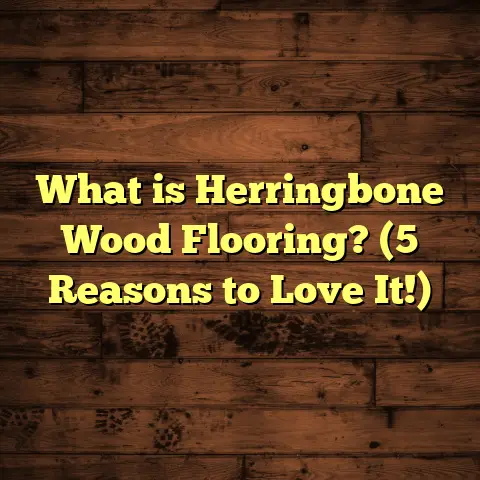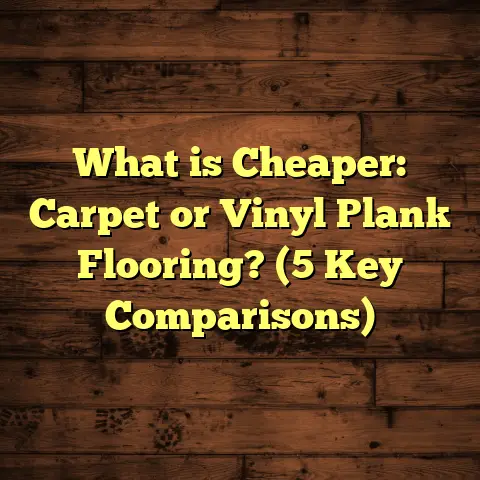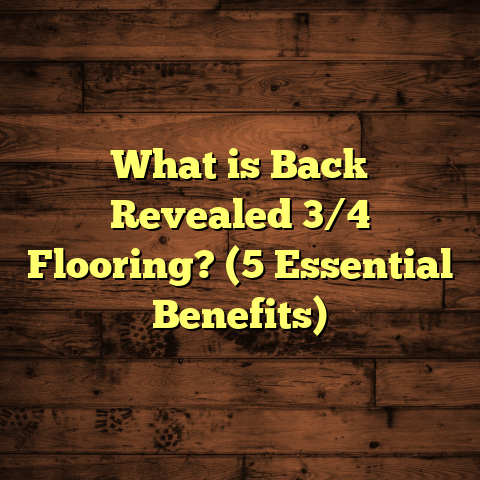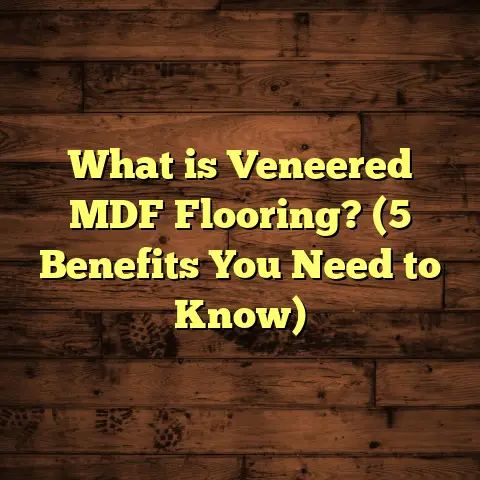What is the Difference Between Vinyl and Laminate Flooring? (5 Key Factors Revealed!)
I still remember the sensation of stepping onto a freshly installed vinyl floor for the first time. It was a crisp morning, and I had just finished laying down planks in a client’s kitchen. That smooth, slightly cushioned surface felt surprisingly comfortable underfoot, yet tough enough to handle the daily hustle of family life. A few weeks later, I was in another house installing laminate flooring in the living room. The way the laminate mimicked real wood so convincingly blew me away—right down to the texture you could feel under your feet. Those moments sparked my curiosity about how vinyl and laminate really stack up against each other. After years of installing both and helping clients decide, I want to share what I’ve learned about these two popular flooring options.
What is Vinyl and Laminate Flooring?
Before jumping into details, let’s clarify what these two types of flooring actually are.
Vinyl flooring is a synthetic product made primarily of polyvinyl chloride (PVC) resin combined with other ingredients like plasticizers and stabilizers. It comes in several formats: sheets, tiles, and planks. The construction of vinyl flooring usually involves multiple layers:
- A backing layer that adds stability.
- A core layer that gives thickness and durability.
- A printed design layer that provides the visual appearance.
- A clear wear layer on top that protects against scratches and stains.
Thanks to this multi-layer setup, vinyl is waterproof, flexible, and relatively soft underfoot compared to harder floors.
Laminate flooring, on the other hand, is a composite product based around high-density fiberboard (HDF). The core is made by compressing wood fibers with resin under heat and pressure. On top of this core lies the photographic design layer that replicates materials like hardwood or stone with high-definition images. The whole thing is sealed with a transparent melamine resin wear layer that protects from scratches and everyday wear.
The key difference here is the wood-based core of laminate versus the plastic-based core of vinyl. This distinction affects everything from how the floors feel to how they perform over time.
1. Material Composition and Structure
Vinyl’s Plastic Backbone vs Laminate’s Wood Core
What really defines how a floor performs is its material makeup. Vinyl flooring’s PVC base means it’s essentially plastic—it can bend and flex without damage, making it forgiving during installation and use. This flexibility also means vinyl floors tend to be softer and warmer underfoot than harder surfaces like tile or laminate.
Vinyl floors come in several types:
- Sheet vinyl: Large rolls laid down in one seamless piece.
- Luxury vinyl tile (LVT): Thicker planks or tiles designed to mimic wood or stone look.
- Luxury vinyl plank (LVP): Vinyl shaped into long planks resembling hardwood boards.
Each type has variations in thickness, wear layer durability, and backing materials depending on manufacturer specifications.
Laminate flooring’s core is compressed wood fibers, which makes it rigid and dense but also vulnerable to moisture. The photographic layer on top is printed with incredibly detailed images of natural materials—oak grain, walnut knots, even distressed barnwood looks are common. Many laminate planks have textured surfaces embossed to feel like real wood grain.
This difference in construction impacts many practical aspects:
- Vinyl can handle uneven subfloors better because it flexes slightly.
- Laminate requires a very flat surface for its click-lock system to function properly.
- Vinyl is lighter and easier to cut during installation.
- Laminate’s rigidity means it can creak if not installed properly over uneven surfaces.
From my own installations, I’ve seen how vinyl’s flexibility made it ideal for remodeling older homes with imperfect concrete slabs. Laminate demanded more prep work but rewarded with stunning visuals that fooled even seasoned hardwood lovers.
2. Water Resistance and Durability
Why Vinyl Shines in Moisture-Prone Areas
Vinyl flooring is almost entirely waterproof due to its plastic composition. This makes it ideal for kitchens, bathrooms, laundry rooms—even basements where humidity or spills are common. Unlike laminate, vinyl won’t swell or warp when exposed to water.
I once installed vinyl flooring in a restaurant kitchen that faced daily mop water exposure and occasional spills—after five years, the floor looked as good as new. Manufacturers often provide water resistance warranties for vinyl products that last up to 20 years when properly installed.
Laminate flooring has improved its water resistance over the years but still isn’t fully waterproof. Most laminates are labeled “water-resistant,” meaning they can handle minor spills if wiped immediately but should avoid standing water at all costs. When water seeps into the HDF core, it causes swelling and permanent damage.
In one case, a client with laminate flooring had an accidental pipe leak under their bathroom—despite quick repairs, several planks needed replacing because of core swelling.
Scratch Resistance & Wear
Durability also includes scratch resistance. Laminate floors generally perform better here because their melamine resin wear layer is harder than most vinyl wear layers. This means laminate can better withstand pet claws, furniture movement, or dropped objects without showing marks.
Vinyl floors do scratch but often hide them better because of their flexible surface and textured finishes. Some high-end luxury vinyl products feature thicker wear layers that resist scratches nearly as well as laminate.
From my perspective, if you have pets or kids who tend to roughhouse indoors, laminate’s scratch resistance might be appealing—though you’ll trade off some water protection compared to vinyl.
3. Appearance and Style Options
Which Looks More Like Real Wood?
If you’ve ever stood in a showroom staring at floor samples, you know how much style matters.
Laminate flooring often wins praise for looking extremely realistic. Thanks to high-definition photographic printing technology combined with embossed textures, laminate planks can mimic hardwood grain patterns down to tiny details like knots or scratches.
Vinyl flooring has caught up rapidly in this department. Luxury vinyl planks especially come in many wood-look patterns with textured surfaces designed to imitate oak, hickory, or even exotic woods like teak. Plus, vinyl offers unique styles like stone-look tiles or abstract patterns that laminate doesn’t typically provide.
One client of mine chose patterned vinyl tiles for their kitchen backsplash area as an unexpected design twist—a move impossible with laminate products due to installation limitations.
Color and Texture Variety
Both vinyl and laminate come in a wide spectrum of colors—from pale whites and greys to rich browns and reds. Vinyl tends to offer more variety with finishes that include matte, glossy, semi-glossy, or even metallic sheens.
Laminate colors are more uniform because they replicate natural materials closely; you won’t find neon-colored laminate floors but can find distressed or hand-scraped looks designed to evoke rustic charm.
Ultimately, your choice depends on personal taste: do you want something ultra-realistic or maybe something bold and modern? Both materials have options for every interior style.
4. Installation Process and Cost
How Are These Floors Installed?
Vinyl installation varies by type:
- Sheet Vinyl: Often glued down over a smooth subfloor.
- Luxury Vinyl Tile/Plank: Usually click-lock floating floors or glue-down options.
- Self-Adhesive Vinyl: Peel-and-stick tiles/planks that are DIY-friendly but less durable.
Vinyl installation can be straightforward for pros and DIYers alike—click-lock systems make floating floors easy to lay without nails or glue. Sheet vinyl requires more expertise due to cutting large rolls precisely and applying adhesive evenly.
Laminate flooring almost exclusively uses click-lock floating installation systems nowadays. Planks snap together firmly without glue or nails and rest on an underlayment that cushions sound and moisture from below.
One challenge with laminate installation is subfloor preparation—it must be perfectly level or the floor will creak or gaps may appear over time. Vinyl is more forgiving here due to its flexibility.
What About Cost?
Cost-wise, vinyl tends to be slightly cheaper upfront than laminate for similar quality levels but there is overlap depending on brands and product lines.
On average:
| Flooring Type | Material Cost (per sq ft) | Installation Cost (per sq ft) | Total Cost (installed) |
|---|---|---|---|
| Vinyl | $1.50 – $5 | $1 – $3 | $2.50 – $7 |
| Laminate | $2 – $6 | $1 – $3 | $3 – $8 |
Prices vary regionally and by quality; high-end luxury vinyl planks can approach or exceed the cost of basic laminate.
When managing multiple projects or trying to budget accurately for clients, I rely heavily on tools like FloorTally. It helps me calculate total project costs factoring in local labor rates, material prices, waste factor percentages (which account for cuts and mistakes), plus optional extras like underlayment or subfloor prep.
Using FloorTally saved me hours of back-and-forth pricing calls during a recent large condo renovation where I managed eight different flooring types across units. It helped me give clients realistic estimates upfront so there were no surprises mid-project.
5. Maintenance and Longevity
What Does Daily Care Look Like?
Vinyl floors are famously easy to maintain. Regular sweeping or vacuuming removes dirt particles that could scratch the surface. Mopping with warm water and mild cleaners keeps them looking fresh without damaging the wear layer.
Some manufacturers recommend avoiding abrasive tools or harsh chemicals since they might dull the protective coating over time.
Laminate floors also require gentle care but need faster cleanup of spills since moisture can penetrate seams if left too long. I always advise clients not to use steam mops on laminate because excess heat damages the core material.
How Long Do They Last?
Vinyl flooring typically lasts between 10-20 years depending on thickness and quality of the wear layer plus use intensity. Commercial-grade vinyl can last longer but costs more upfront.
Laminate flooring generally has a lifespan of 15-25 years if maintained well but may show wear sooner in heavy traffic zones or if exposed frequently to moisture.
In several commercial projects I worked on—for retail stores with high foot traffic—vinyl floors performed consistently well for over 10 years without needing replacement. Laminate works better in residential settings with moderate foot traffic where style longevity matters more than moisture resistance.
My Personal Experiences With Both Floors
Over my career installing hundreds of homes’ floors, I’ve learned a few things firsthand about these two materials beyond what specs tell us.
One memorable job involved a family with two young kids and a dog who wanted durable floors throughout their open-plan kitchen/living space. After discussing pros and cons, we chose luxury vinyl plank for its ability to handle spills without warping plus moderate scratch resistance from thick wear layers.
Another time I recommended laminate flooring for a single retiree who loved the authentic wood look but didn’t have pets or kids causing heavy wear or moisture issues inside her home.
In my own kitchen renovation last year, I went with luxury vinyl plank because my kitchen sink area occasionally flooded due to plumbing quirks (don’t ask!). Installation was simple thanks to click-lock design over an uneven concrete slab where traditional hardwood wouldn’t have worked well. The floor feels warm underfoot on cold mornings and cleans easily after cooking messes—plus visitors often mistake it for real hardwood!
Some Data Points Worth Noting
- The global vinyl flooring market has grown steadily at around 5% annually over the past decade due to rising demand for waterproof floors.
- Luxury vinyl tile/plank sales have increased by roughly 20% year-over-year as technology improves realism.
- Laminate flooring market growth has slowed slightly but remains strong in residential sectors thanks to affordability.
- Indoor air quality studies show both vinyl and laminate meet strict VOC emission standards when installed properly.
- According to Consumer Reports surveys, about 60% of homeowners who chose vinyl cited waterproofing as their main reason; 55% who picked laminate prioritized wood-like appearance.
Choosing Between Vinyl vs Laminate: What Should You Think About?
Ask yourself some questions:
- Does your space get wet often? Bathrooms? Kitchens?
- Do you have pets or kids who might scratch floors?
- Do you want something that feels softer or harder underfoot?
- How important is authentic wood look versus pattern variety?
- What’s your budget range including installation?
- Are you planning DIY or hiring pros?
- How long do you expect the floor to last before replacing?
Answering these will narrow down your choice significantly.
Wrapping Up My Thoughts
If you want waterproof floors that handle heavy use gracefully, vinyl is usually the best bet—especially modern luxury vinyl planks combining durability with attractive looks and easy installation.
If authentic wood appearance combined with scratch resistance matters most—and moisture isn’t a big concern—laminate offers great value while giving you that classic hardwood feel at a fraction of the cost.
Both materials have come a long way; choosing depends on your home’s conditions and lifestyle preferences.
If you’re planning your own flooring project or want help deciding which option fits your needs best, don’t hesitate to ask me anything! Whether it’s installation tips, cost calculations using tools like FloorTally, or how to maintain your new floor long term—I’m here with real-world experience ready to share.
Thanks for sticking with me through this detailed look at vinyl versus laminate flooring! Hopefully now you have a clearer picture when making your next flooring decision.





